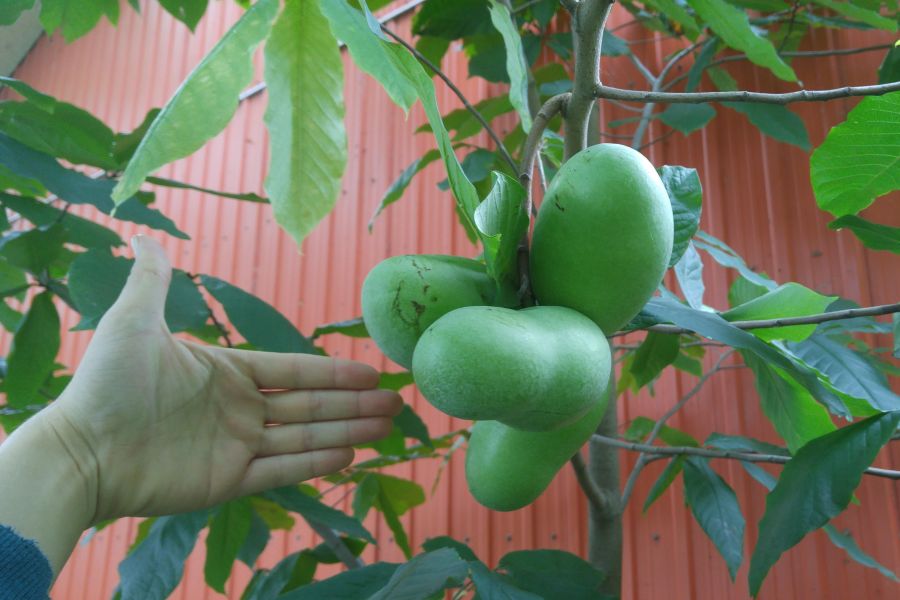A tropical-tasting fruit that’s native to Ontario? It sounds like something entirely made up, but it’s real.
It’s called a paw paw (or Asimina triloba), and most people don’t know they even exist, though they’ve been growing in Ontario since long before Canada was a country.
The bright green fruit is about the size of a kiwi, yellows when ripe, and tastes like it’s straight from a tropical island, having hints of banana, papaya and melon, with a texture like a rich custard.
Many paw paw enthusiasts say it’s a taste that’s hard to compare directly to anything else, and those who know about them tend to keep the secret fruit pretty hush-hush, especially if they know where a wild patch is.
And yes, this secret fruit grows in — and is native to — a very limited region of eastern North America, including Niagara and is actually America’s largest native fruit, according to Green Barn Nursery, which specializes in paw paws.
Linda Grimo, of Grimo Nut Nursery in Niagara-on-the-Lake, which grows and sells paw paw trees — and fruit, if you’re there at the right time — says paw paws are native to the Carolinian forest and that the fruit was a source of food for Indigenous peoples long before Canada or the U.S. were around.
But you won’t find them in stores, Grimo says, because they have an extremely short shelf-life, turning a nasty brown (sort of like an overripe banana) about a week after they’re picked, if they’re picked just as they ripen.
“They don’t have a long shelf-life but they do have an incredible flavour,” she said.
Many sources credit Indigenous peoples with spreading the paw paw tree across the eastern U.S. to eastern Kansas and Texas, and from the Great Lakes to near the Gulf of Mexico. Different sources claim the tree is American or Canadian, but Grimo says it can’t really be looked at as either.
“It doesn’t have a border because it’s a native species and it was growing before there were borders. So anybody who tells you it’s Canadian or American is kidding themselves,” says Grimo.
The fruit grows in clusters, similar to bananas and is extremely hard to cultivate. Seedlings take about five to seven years before they start yielding any fruit at all, says Grimo.
A grafted paw paw tree can yield in about three years, and once the trees start to bear fruit they produce a large blood-red flower at the start of the season, which later becomes the custardy fruit.
Even stranger, the flowers aren’t pollinated by bees — they’re naturally pollinated by carrion flies and beetles because the flowers smell like rotten meat, which attracts pollinators who normally feast on things like dead animals.
Appetizing, right? Don’t worry though, the fruit doesn’t smell or taste anything like foul meat, though you’ll be hard-pressed to find one — Grimo says the nursery typically sells out quickly, but if you’re interested in hunting some down, now is the time to try at local restaurants serving up seasonal dishes.
Paw paws are in season in late October, and though they are rare, you can track them down if you know where to look, though plenty of growers won’t sell the fruit until they’ve secured enough seeds for the next nursery season, says Grimo. Grimo Nut Nursery is one of such growers.
The fruit is a member of a broad botanical group, commonly known as the custard apple family, and is often nicknamed as an Ontario papaya or a Michigan banana. It is also referred to as a North American papaya, since papayas are also sometimes referred to as a paw paw.
There’s even a town in Michigan named after the fruit.
Popularity of the paw paw is growing, says Grimo, who has been growing the trees for years now and sells out every year, as well as selling to local restaurants like Backhouse in Niagara-on-the-Lake, which actively seeks out interesting local fruits, nuts and vegetables.
Grimo says the Ontario Ministry of Agriculture, Food and Rural Affairs (OMAFRA) is currently researching what the plant would be like as a crop in Ontario.
“There is interest on the government’s part. It’s just going to take time,” says Grimo. “The more people discover it, the more it becomes a gem of Ontario.”
If you want your own paw paw tree, a two to three-year-old tree is in the range of $25 to $50, but be prepared to wait for the fruit. As do most great things, paw paws need time to develop.










